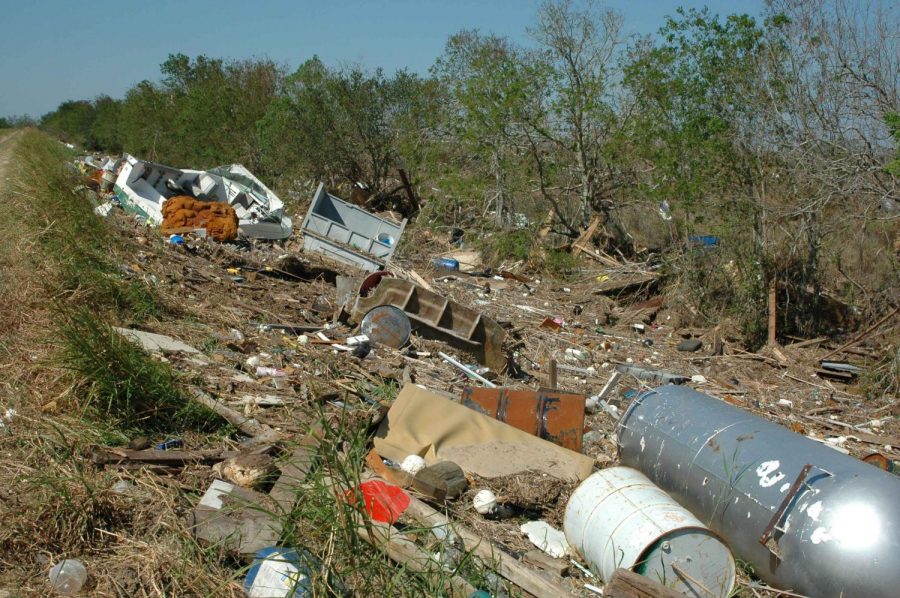Hurricane Havoc in the Southeast
Courtesy of U.S Fish and Wildlife Services. A considerable amount of debris has been left behind by hurricanes.
Harvey. Irma. Jose. Maria. This year’s hurricane season has been catastrophic, tearing apart the Caribbean, the Gulf Coast, and the southeastern Atlantic seaboard. Affected cities have suffered staggering amounts of damage.
The destruction started when Hurricane Harvey laid waste to the Texas coastline on Friday, August 25th. By the time the fury subsided, Harvey had cost the state an estimated 180 billion dollars in damage. Harvey was a category 4 hurricane, which consisted of wind speeds of a staggering 131 to 155 miles per hour. Wind speeds this high often cause structural damage. Power outages to the affected areas are also an issue. Along with the high wind speeds, Harvey dropped such large quantities of rain over Houston that the earth’s crust sank a full two centimeters because of the weight of the water.
Almost forty-three inches of rain had fallen in several cities by August 30th, a rain gauge measured nearly fifty-two inches of rain, breaking the previous record set in 1978. An estimated twenty-seven trillion gallons of water drenched Texas and Louisiana during the ten days that Harvey was in full force. This large amount of rain flooded cities, killing several people and damaging over 20,000 houses. The massive amounts of flooding convinced Gallery Furniture in Houston to open their large warehouses as shelter for those who needed it during the rest of the storm. A total of seventy-one people died during Harvey, either due to house collapses or drowning as a result of the extremely high waters.
As Harvey subsided, Irma took over, a category five hurricane with wind speeds of 187 mph. Hurricane Irma’s path was over the Gulf Coast and parts of Florida. Irma first hit the island of Barbuda in the Caribbean, destroying nearly thirty percent of property and killing a toddler whose family was fleeing. Irma ransacked much of the surrounding islands without causing much damage as it had “calmed down” to a category one hurricane, save for a few power outages and some debris. The hurricane maintained this calmer profile before hitting the coast of Florida, where Irma went back up to a category four. It left 10,000 people homeless in the Upper Keys, while the Middle and Lower Keys had been hit harder. A single engine plane also crashed in the area while getting photographs of Hurricane Irma, luckily the pilot and the passenger were both found alive, floating on commercial trap buoys. Roughly 5.6 million people were evacuated, either moving in with relatives, shelters, or by large ships provided by the US military to assist with the evacuation. Hurricane Irma is projected to cost roughly 120 billion dollars and affect 1.2 million people, numbers that could rise as more accurate accounts of the damage are reported.
While Hurricanes Harvey and Irma are the two main storms that have caused massive amounts of damage, two other hurricanes, Jose and Maria, started out following Irma’s path however altered in both course and category. Hurricane Jose is a category one storm and is expected to veer east. On the other hand, Hurricane Maria is continuing along a path very similar to Irma’s, as it started out as a category five, toned down to a category one and is expected to ramp back up to a category five as it hits Puerto Rico. Dominica has already requested aid for Maria because the storms destruction has already begun.
Research done by Climate Central, a nonprofit organization that observes climate change, has stated that while the hurricanes are not a by-product of climate change, the massive amounts of flooding are caused by global warming. Warmer sea temperatures resulted in the Clausius-Clapeyron Equation, which dictates that there is a three percent increase in atmospheric moisture for every half a degree celsius of warming. Warmer temperatures mean more moisture in the air, which results in more rainfall, greater storm surges and more damage done during a hurricane.
Harvey is an excellent example of this, sea temperatures had risen higher, resulting in roughly three to five percent of atmospheric moisture, which assisted in the tremendous flooding that left much of the Southeast underwater. Another side effect of the hurricanes, that has since been fixed, was the increase in gas prices due to shutdowns or power outages of factories due to the flooding.
Only time will tell how sever the effects of climate change will become in the future.






